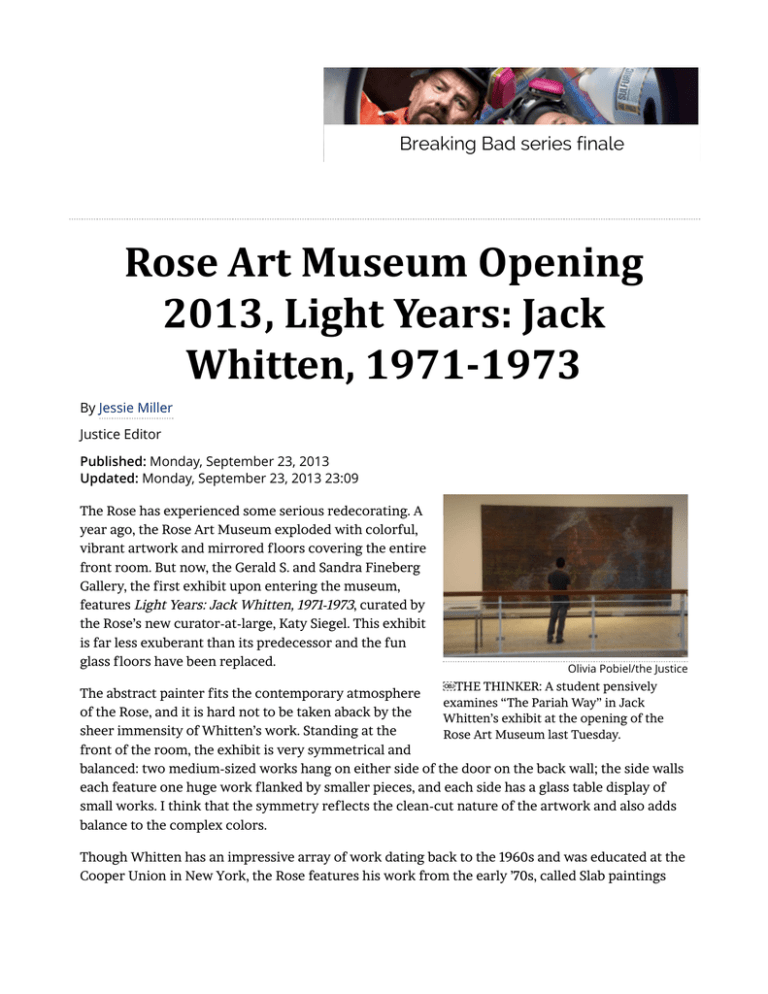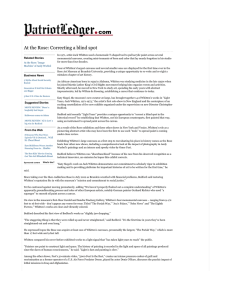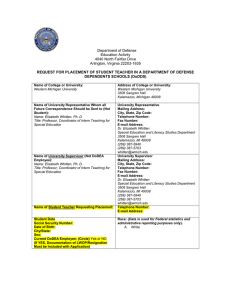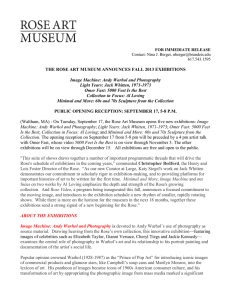Document 14406832
advertisement

Breaking Bad series finale Rose Art Museum Opening 2013, Light Years: Jack Whitten, 1971-­‐1973 By Jessie Miller Justice Editor Published: Monday, September 23, 2013 Updated: Monday, September 23, 2013 23:09 The Rose has experienced some serious redecorating. A year ago, the Rose Art Museum exploded with colorful, vibrant artwork and mirrored floors covering the entire front room. But now, the Gerald S. and Sandra Fineberg Gallery, the first exhibit upon entering the museum, features Light Years: Jack Whitten, 1971-1973, curated by the Rose’s new curator-at-large, Katy Siegel. This exhibit is far less exuberant than its predecessor and the fun glass floors have been replaced. Olivia Pobiel/the Justice THE THINKER: A student pensively examines “The Pariah Way” in Jack Whitten’s exhibit at the opening of the Rose Art Museum last Tuesday. The abstract painter fits the contemporary atmosphere of the Rose, and it is hard not to be taken aback by the sheer immensity of Whitten’s work. Standing at the front of the room, the exhibit is very symmetrical and balanced: two medium-sized works hang on either side of the door on the back wall; the side walls each feature one huge work flanked by smaller pieces, and each side has a glass table display of small works. I think that the symmetry reflects the clean-cut nature of the artwork and also adds balance to the complex colors. Though Whitten has an impressive array of work dating back to the 1960s and was educated at the Cooper Union in New York, the Rose features his work from the early ’70s, called Slab paintings because of their size. At this time, he began to further experiment with alternative creative processes and unconventional materials, ultimately creating an artistic technique where he dragged an oversized T-shaped piece of wood across a canvas to create the desired effect of lines. The Alabama native was able to create his own version of abstractionism while escaping from the typical hand-brushed canvas art style. The selection of works are diverse in appearance yet still maintain a sense of continuity. They all have a feeling of austerity, simplicity and organized abstraction, especially in comparison to Walead Beshty’s exhibit— the shattered- mirror floor—that previously occupied the space. One work on display, “Third Testing,” created in 1972, has a texture similar to concrete pavement, and the brown color with subtle lines running through almost looks like a rock formation. Though simple, the acrylic painting is a good example of Whitten’s style and its placement right next to the exhibit description is an ideal introduction. Two of the largest works are entitled “The Pariah Way” and “Asa’s Palace,” both created in 1973. Both are breathtaking to stand in front of, and you feel fully absorbed by their immensity and beautiful detail. Whitten has a way of maintaining simple and monochromatic works, yet also introducing pops of color that add another layer to the piece. In “The Pariah Way,” the use of green, blue and rust color splotches in horizontal layers up the painting creates what looked to me like a skyline. It was my favorite piece in the exhibition and I loved the dark background with patches of muted colors. “Asa’s Palace” is a demure pinkish-purple with abstract blobs of yellow throughout. To me, the name is particularly interesting, and I’m left wondering what the story or inspiration is behind it: whether it represents a specific place Whitten has visited or an abstraction of an idea. “The Eighth Furrow,” a medium-sized work, stands out with its copper coloring and pounded texture. It is very monochromatic, but the texture offers an interesting depth. Of the smaller works, a set of six “Acrylic Collages” hangs on the walls—colored acrylic pieces arranged abstractly on light brown linen. The collages are pretty much the definition of abstraction, meaning the pieces are open to interpretation of each individual viewer—maybe you see an eye or a bird. The two sets of small series in the exhibit tables on opposite sides of the room are entitled “Cut Acrylic Series” and “Dispersal ‘B’.” The former are three works of pastel and powdered pig- ment on paper and are mostly black with patches of blue, purple, green and red. A varying amount of the white background is seen, and some areas are darker in color. “Dispersal ‘B’” is four works of dry pigment and reflects Whitten’s interest in spray and splatter techniques that basically create themselves on the paper. However, in both collections, the glass of the case added a layer of glare and detracted from the overall viewing of the pieces. Whitten’s exhibit offers a unique addition to the Rose this semester and is definitely different than its usual modern and contemporary exhibits. While abstract, the paintings all have an air of timelessness and romanticism stemming from the rich, yet muted colors and simplicity. I thoroughly enjoyed the exhibit and am looking forward to Jack Whitten’s upcoming visit and symposium to the Rose in October. AROUND THE WEB ALSO ON THE JUSTICE Citizens Over 50 May Qualify to Get $20,500 this Year Moneynews Diversity is comprised of a multitude factors, race included - … 8 comments 8 Common Grammar Mistakes You Should Never Make Again OPEN Forum ‘Riddick’ fails to develop beyond superficial level - The … 1 comment '90s Babes Who Are Still Hot Today Answers.com University to kick off online learning involvement in Spring 2014 1 comment How Crazy Are You in Bed? Take This Sex Quiz Lifescript Student Union treasurer Aidasani resigns - The Justice - … 2 comments 0 comments WHAT'S THIS? ★ 0 Leave a message... Oldest ✉ Subscribe Community d Add Disqus to your site Share ⤤ ⚙




